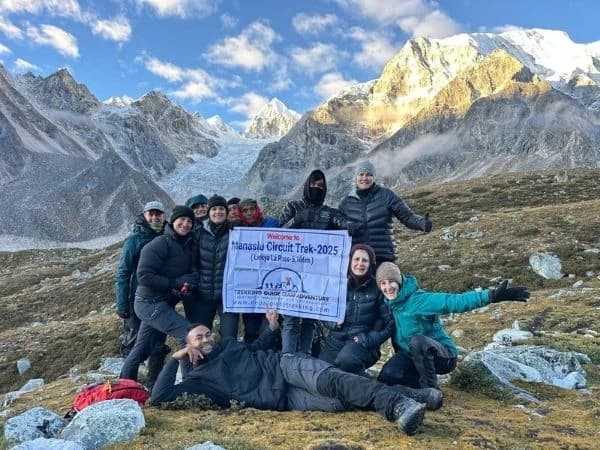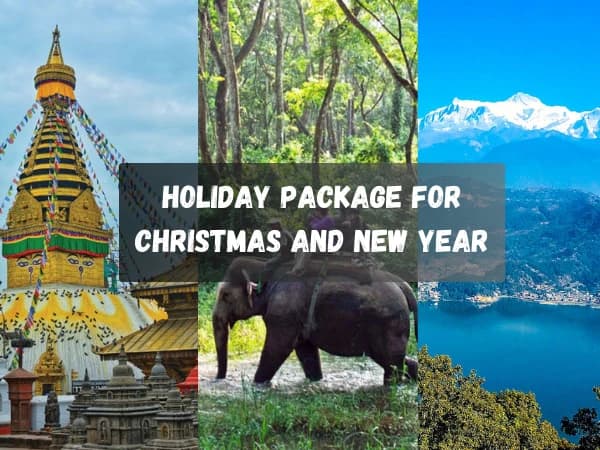Planning to go for the Langtang Gosaikunda Trek but not sure of its difficulty level? This blog provides the difficulty level, elevation, fitness level required and practical tips to help you prepare and complete the trek with safety.
How Hard is the Langtang Gosaikunda Trek? Full Difficulty Guide
Introduction

The Langtang Gosaikunda Trek is a unique and famous trek that includes both Langtang Valley and the sacred Gosaikunda Lake. Langtang Valley is renowned for its scenic beauty, diverse flora and fauna in Langtang National Park, whereas Gosaikunda is known for its sacred lakes. Besides Gosaikunda, there are other lakes like Bhairabkunda, Surya Kunda, Ram Kunda, and Lahachok Lake. So, this trek provides both the benefits of a peaceful rural escape and a chance to experience the divine energy of the sacred lakes.
This trek is located to the north of Kathmandu Valley, offering both spiritual calmness and mesmerizing scenic beauty, but how hard is the trek? You're not alone if this trek was on your bucket list and you're unsure if the Himalayan adventure is appropriate for your level of fitness or trekking experience. Many hikers think about whether the trek is as accessible as the Annapurna region or just as challenging as Everest Base Camp Trek.
In this blog, we will cover everything that a trekker needs to know before Langtang Gosaikunda trek. This will include altitude, conditions of trail, level of fitness required, real trekkers stories and so on.
Overview of the Langtang Gosaikunda Trek
The Langtang Gosaikunda is a spiritual and meaningful journey that combines famous trekking destinations in Nepal i.e. Langtang Valley and the holy lake, Gosaikunda. The trek commences in the village of Rasuwa district - Syabrubesi after 7-8 hours by bus from Kathmandu. Gradually, the trail ascends through green forests, open meadows, traditional Tamang villages and finally snowy passes and sacred lakes.
Depending upon the pace, experience of the trekker and the condition of the trail, it takes around 9-13 days. During these days the trek covers, the distance of around 68-80 miles (110-130 km) and reaches the Lauribina La Pass, maximum altitude of 15125ft (4610 meters).
On the way, trekkers can encounter landscapes with rhododendron, yaks carrying load, areas in the glaciers and rocky mountain as well.
Major highlights of the Langtang Gosaikunda Trek

- Kyanjin Gompa: It is a beautiful monastery at the altitude of 3870m where you can see panoramic views of Langtang Lirung and surrounding peaks.
- Langtang National Park: Red pandas, Himalayan thars, and a wealth of species can be found there.
- Gosaikunda Lake (4,380 m): A holy lake having religious importance for both the Hindus and Buddhists.
- Tamang and Sherpa culture, with warm hospitality, prayer flags, and monasteries.
The trail provides a more peaceful and genuine trekking experience, as it is secluded and less commercialized than the Annapurna or Everest regions. Nevertheless, it also means there are fewer services and facilities.
Trek Difficulty Rating: How Hard is it?
Depending on your degree of physical health, prior trekking experience, and the season, the Langtang Gosaikunda trip is typically rated as moderate to hard. The route includes considerable elevation gain, hard climbs, and several long trekking days, particularly around the Lauribina La Pass (4,610 m), even if it doesn't reach the extreme altitudes of Everest Base Camp or require for technical climbing skills.
The trek is fairly possible for hikers with a basic level of fitness and some prior trekking experience. However, some parts, particularly after Thulo Syabru and during the ascent to Gosaikunda, may be mentally and physically difficult for beginners without any prior trekking experience. However, the ability to change your pace, plan for rest days, and rely on clearly documented routes with well-established tea houses along the way make this walk achievable.
Compared to other popular Nepal treks:
• It's doable than Everest Base Camp, which requires more than two weeks and reaches above 5300m (5500m at Kalapatthar)
• Though quieter and a little less crowded, Langtang is about on same level with Annapurna Base Camp.
• Due to the longer trail and higher height, it is more difficult than shorter treks like Ghorepani-Poon Hill or Mardi Himal.
The winter because of the snow and monsoon due to rainfall the trail is slippery and there is risk of landslides which leads to increase in the trek’s difficulties. The majority of physically fit trekkers find the walk to be difficult but incredibly rewarding during the best trekking seasons, which are spring (March–May) and fall (September–November).
In a nutshell, it's not easy, but it's also not impossible. Most adventure-seeking hikers can successfully complete the Langtang Gosaikunda trek with the correct planning and attitude.
Key Factors That Influence Difficulty

How difficult the Langtang Gosaikunda trek is for each person depends on a number of factors. Although altitude presents the greatest obstacle, other elements like as topography, climate, and physical fitness are all crucial. The factors are:
a. Altitude and Acclimatization
At 4,610 meters (15,125 feet), Lauribina La Pass, the trek's highest point, is considerably above the altitude sickness threshold. Even the most fit hikers may have symptoms including headache, nausea, dizziness, and exhaustion if they climb too quickly.
Recommendations to minimize the risk:
- Follow a progressive climb itinerary.
- Include a day for acclimatisation at Chandanbari or Kyanjin Gompa.
- Drink plenty of water and avoid alcohol.
- Be aware of the early warning signals of acute mountain sickness (AMS) and descend if necessary.
Prevention is crucial because the Langtang route has fewer health posts than the Annapurna and Everest trek.
b. Trekking Duration and Daily Hours
Depending on the route you choose and the days you take off, the trek usually lasts 9 to 13 days. Five to seven hours of hiking are required for each trekking day, though some days may be longer (particularly when crossing the Lauribina La pass or descending from Gosaikunda).
Fatigue can result from longer daily hours, particularly if you're not used to hiking for several days. Energy levels can be controlled by proper rest, a healthy pace, and planning some shorter days.
c. Topography and Trail Conditions
The trail includes:
- Progressive forest climb
- Steep stone staircases
- Slopes that are narrow
- Uneven and rocky high-altitude routes
The ascent to Lauribina La Pass is especially challenging due to the rocky landscape and inadequate air. Although the trail is sloping and forested in the lower areas (such as Syabrubesi to Lama Hotel), landslides and difficult sections are common.
It is strongly advised to have solid hiking shoes and trekking poles.
d. Weather and Seasons
Weather significantly affects difficulty:
- Spring (March–May): Ideal conditions include moderate temperatures, blooming rhododendrons, and stable weather.
- Autumn (Sept–Nov): Beautiful vistas of the mountains, dry pathways, and clear skies.
- Winter (Dec–Feb): Snow-covered, cold passes with a chance of closures. can be quite difficult.
- Monsoon (June–Aug): Risk of landslides, muddy trails, and heavy rain. Not advised for the majority.
Regardless of the season, always check local conditions before leaving and pack sun protection, thermal layers and rain clothing.
e. Physical Fitness Requirements
A moderate level of cardiovascular fitness and leg strength are necessary, but you don't have to be an excellent athlete. Although not required, prior multi-day trekking experience is a plus.
Recommended preparation:
- Train for at least four to six weeks in advance.
- Include leg exercises (lunges, squats), cardio (running, swimming), and backpack hiking.
- Get used going on stairs or uneven ground.
Another important factor is mental strength; Whether you complete the trek or not is also determined by how is your mindset and capacity to continuing despite the exhausted body.
Special Challenges Along the Trek
Although many people can complete the Langtang Gosaikunda trek, there are some sections and circumstances that make the trip even difficult, particularly for those who are not used to mountain conditions or are trekking for the first time.
1. Steep Climbs and Hike Back
The hike from Thulo Syabru to Lauribina, which includes long, steep way and also at higher elevations, is one of the most difficult parts. It can also affect the knees while hiking down from Lauribina La Pass, especially if the trail is covered in ice. During these time, trekking poles can greatly benefit you to avoid joint strain.
2. Thin Air and Cold Nights
The air becomes considerably thinner as the walk ascends over 4,000 meters. At this altitude, even quick climbs might leave you out of breath. Particularly outside of the hiking seasons, nights in locations like Gosaikunda and Kyanjin Gompa can be extremely cold. Recovery and the quality of your sleep depend on staying warm and hydrated.
3. Snow and Ice in Shoulder Seasons
You should expect snow close to the pass and frozen areas surrounding the lakes if you're walking in late autumn (November) or early spring (March). Even if the trails are accessible, they can get slippery and require extra care, particularly in the early morning when the ice is harder.
4. Limited Facilities at Higher Elevations
There are fewer food options and more simple tea houses as you go up. Internet access might be irregular and power can be expensive or limited. Langtang may seem a little raw to trekkers used to the facilities of the Annapurna or Everest routes, which can be mentally exhausting. Many hikers discover that the sensation of isolation, genuineness, and natural beauty outweighs these difficulties.
Tips to Make the Trek Easier

While the Langtang Gosaikunda trek does present some challenges, there are plenty of ways to make the experience smoother, safer, and more enjoyable. With a bit of preparation and the right mindset, you can significantly reduce the trek's difficulty level.
1. Go Slow and Acclimatize Properly
It is recommended not to rush. Pacing is crucial when climbing at high altitudes. Select a route that allows for at least one day of acclimatisation, either at Chandanbari or Kyanjin Gompa. Give your body enough time to acclimatise to the altitude by taking frequent rests.
2. Hire a Guide or Porter
You can benefit from having a local guide for emergency circumstances, routing, and weather information. A porter can carry your heavy bag, letting you up to stroll comfortably. This is particularly beneficial on long or rugged days.
3. Stay Hydrated and Eat Well
Symptoms of altitude are made worse by dehydration. Avoid alcohol at any cost and drink three to four liters of water each day. If you are craving for food at higher elevations, eat meals high in carbohydrates for energy.
4. Use the Right Gear
Buy good-quality sleeping bags, hiking poles, thermal layers, and trekking boots. Comfort and endurance are greatly improved by lightweight but durable gears.
5. Train in Advance
Prepare to walk uphill while carrying a daypack. In the weeks leading up to your walk, include aerobic, leg strengthening, and even stair training.
6. Prepare Mentally
The trip presents both a mental and physical struggles. Isolation, exhaustion, and bad weather can wear you down. You may overcome the difficult times with mental flexibility and a positive mindset
Who Should and who Shouldn’t Do This Trek?
Although many various kinds of trekkers can complete the Langtang Gosaikunda trip, it is not the best option for everyone. Prior to start with the trek, it is important to understand your level of physical fitness, trekking objectives, and your willingness to take risks.
Who Should Consider This Trek
- If you are moderately fit and can deal with gradual rises in altitude and walk for five to six hours each day with a backpack.
- Hikers who are seeking for secluded, genuine, cultural trek and alternative to Everest and Annapurna regions will find Langtang's less-crowded trails and warm Tamang hospitality refreshing.
- The natural himalayan landscape and Gosaikunda Lakes may appeal to spiritual or nature-loving travellers.
- Adventurers on a tight budget will value Langtang's costs in comparison to more crowded areas.
Who Might Struggle
-
Because of the risk of altitude, anyone with heart or respiratory conditions should see a doctor before going.
-
If they don't prepare well or accompany a guide, absolute beginners who have never hiked for more than a day or experienced altitude may find the trek too much to handle.
-
Particularly at higher elevations, travellers who anticipate luxury may be let down by the simple facilities.
-
Trekkers should use extreme caution when hiking during the winter or monsoon seasons because of the possibility of snow, cold, or landslides.
In summary, Langtang Gosaikunda will reward you tenfold if you're curious, considerably fit, and willing to take on a mental and physical challenge.
Conclusion
So, how hard is the Langtang Gosaikunda trek? In a nutshell, it's challenging yet very rewarding. Although it's not easy, it's also not an expedition-level task. Most trekkers with an adequate level of fitness can finish the journey and return with lifelong memories if they prepare, think, and pace themselves properly.
The trek offers amazing views of the mountains, secluded trails, and opportunities to interact with locals to discover about their culture. However, it also tests your physical limits with difficult ascents and steep elevations, particularly at Lauribina La Pass. This region is more tranquil and natural than the crowded Everest and Annapurna routes, providing you with a genuine and more individualized trekking experience.
Langtang Gosaikunda is a great option if you're looking for a Himalayan adventure that perfectly balances physical difficulty, aesthetic beauty, and a cultural experience.
Just keep in mind to be cautious, show respect for the mountains, and plan in advance.





